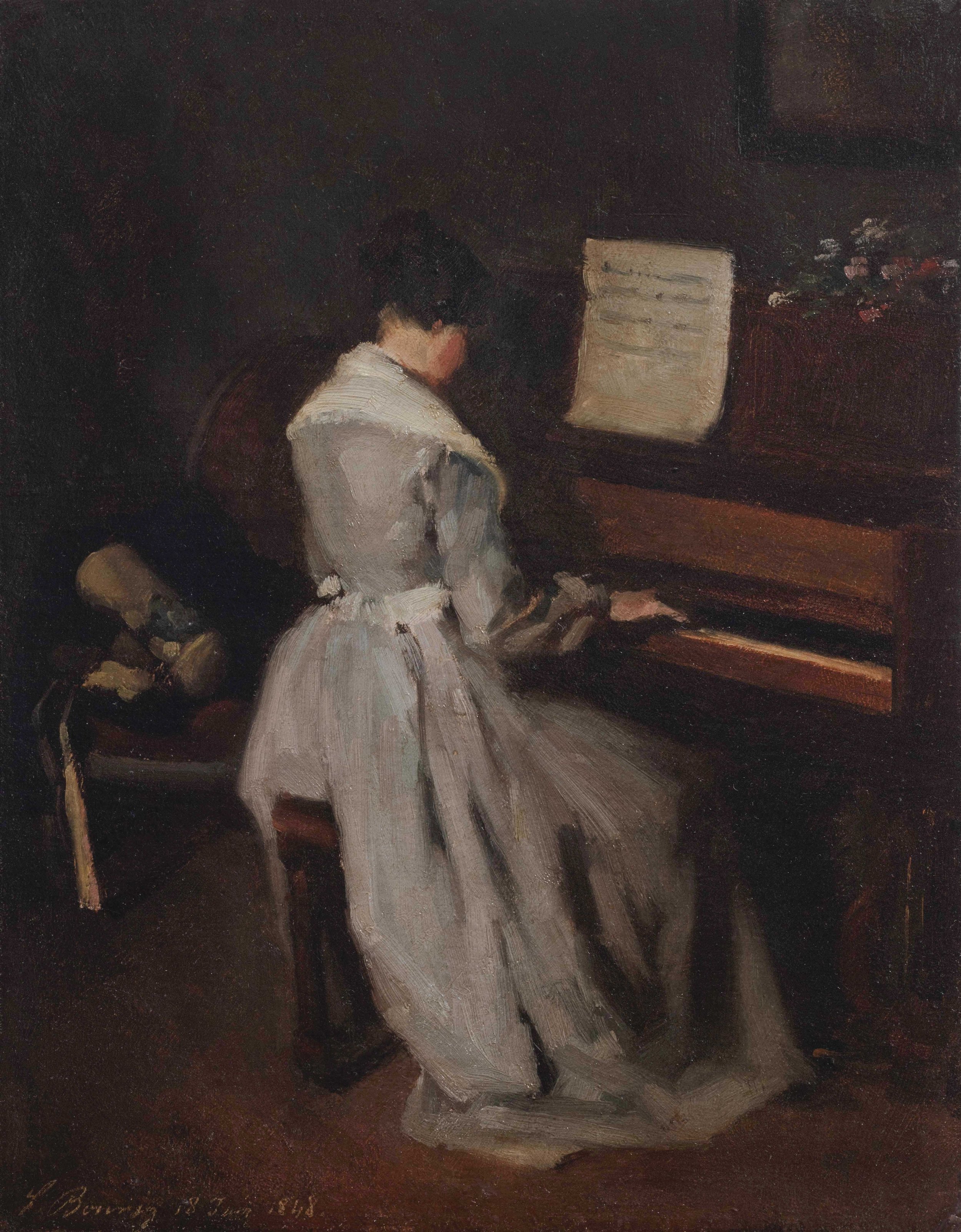FRANÇOIS BONVIN (Paris 1817 – Saint-Germain-en-Laye 1887)
The Piano: June 18, 1848
signed and dated F. Bonvin 18 Juin 1848 in the lower left; and inscribed on the stretcher “tableau ayant appartenu à Mme Aurore SAND petite fille de Georges SAND V. Dubourg 27/4/51 Drouot”
oil on canvas
9 5/8 x 7 1/2 in. (24.5 x 19 cm.)
MIDDLE CLASS ICONS
An interior scene of a girl playing piano. This subject in 19th century paintings is not unfamiliar. Name almost any French (or European) painter of that period and you can probably find some version of this scene in their oeuvre. But what prompted this theme to become so popular? Although these were not controversial, they were definitely not spiritual. Were patrons demanding these scenes? How did the 19th century ‘girl playing piano’ become so de rigeur?
In much of Europe, before the industrial revolution, people generally lived in the countryside. There was barely a middle class and upper and lower classes had almost no interaction. Que the industrial revolution, which changed life for almost everyone – in Europe and America. Across Europe there was an increase in railroads, making transportation cheaper and more accessible, and people started flocking to the cities. Here they found jobs, started businesses and began to grow their wealth. The rise of the middle class had begun.
Hand and hand with the industrial revolution and middle-class accession, came an increased attention to culture. The (Paris) Salon, which began in the mid 18th century, gained huge popularity, with up to 50,000 people attending on a Sunday and over 500,000 from around the world coming over its 8-week run. This event, which quickly turned into a global one, launched a wide-spread appetite for art the world had never seen. With the middle-class able to afford tickets to the exhibition, their demand for art only grew.
The Salon did more than fuel the public’s passion for art, it altered the subject matter. No more were the artists at the whim of a single patron or under the watchful eye of the church. This was a chance for artists to execute their own visions and ideas, for themselves and a public they could identify with. The judges were conservative, and the critics were harsh, but the artists had found an escape from the stifling creative process of being owned and were introduced to an entire section of society also coming out from under the aegis of the church and nobility.
Next to this interest in fine art, a wealthier middle class gained interest in music and amateur musicianship, fuelling an emerging musical industry and mass production of instruments. The keyboard was the tool of choice, given that it was relatively easy to produce a tolerant sound quality compared to woodwind or bow instruments. Therefore, the piano became central to the proper education of middle-class children. For girls, learning to play an instrument was considered more essential than reading, and an enchanting way to charm potential suitors. This middle-class upsurge, with all its material and ideological norms resulted in a swell of families striving to display their level of wealth and prosperity. Magnus Resch, an art market economist recently said ‘Two hundred years ago, it was very common to have 20 to 30 artworks per household…’ Art and cultural prowess had definitely become more accessible and significant status symbols for the middle-class.
The subject of a young girl playing piano became an iconic symbol. To have a painting with this subject sent a clear message to all your guests that you had arrived. These lovely, serene images of girls ticked almost every box possible. The young girl, a symbol of education and virtuosity, playing piano says clearly that the owner of the picture has taste and understanding of the world around them. With the glimpse of art hanging next to her on the wall, it tells us that she too has arrived. She is just like the owner. A well-educated young lady, properly trained in the ways of society.
Bonvin was an artist of immense talent. His incredibly humble background, lack of training and quiet personality did not help him fight for attention in the Salon. Not as well-known as his friend and contemporary Courbet, he struggled to find the finances to support himself throughout his career, still working clerical jobs even after he had won medals at the Salon. This charming painting of The Piano: June 18, 1848 was painted only four years after the artist decided to dedicate himself to painting and a year before he won his first Salon medal.
Although the subject matter may not be original, the intimacy which the artist provides feels different. The young girl strikes an isolated, lonely figure, put on show to attest to her family’s good standing. Bonvin was an outsider himself, untrained and extremely poor. He was known to paint from direct observation and so it can be assumed he was there, in the room, as this young girl performed. You almost feel that he could relate to her, the desperation to prove that you belong, showing off skills to demonstrate your worth, likely the reason his genre scenes were popular with the middle-class of that time. Affordability and relatability – aren’t these the reasons so many of us buy art?
3 March, 2022
Click here to read about the significance of June 18, 1848, and our full fact sheet.
